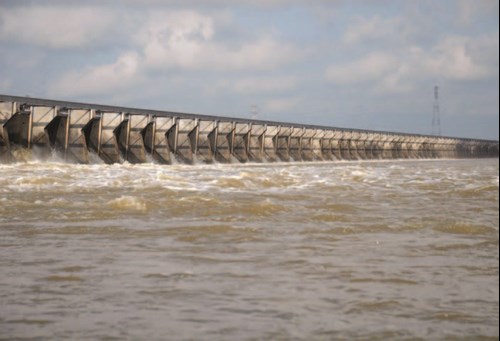Blanket of Water
9/10/2019 3:23:01 PM
By MDWFP Staff
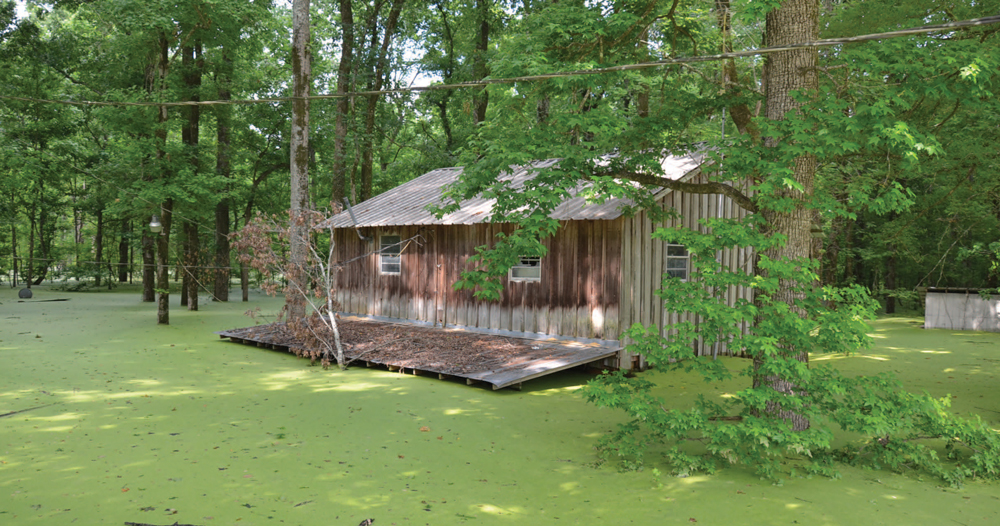
The Great Flood of 1927 has been considered the most destructive river flood in the history of the United States. More than 26,000 square miles were submerged and 700,000 people left homeless in the Lower Mississippi River Valley, many of whom were displaced permanently. It was a history-altering event not only for the affected area but for the nation.
The economic effects were considered staggering. Total direct losses throughout the Mississippi drainage area amounted to almost $1 billion, including $102.6 million in crop losses. Former Mississippi Senator LeRoy Percy told the 1928 House Flood Control Committee, “We are bankrupt; all of the 29 levee districts are up to their limit in taxing capacity.”
In the aftermath, Congress created the Flood Control Act of 1928, which tasked the U.S. Army Corps of Engineers (USACE) with solving the flood issues and, essentially, taming the Mississippi River. USACE then created the Mississippi River and Tributaries (MR&T) project, a flood-control system that features levees, floodways, channel improvements, and tributary basin improvements.
“What we were dealing with is a river that’s a watershed for 41% of the United States,” said USACE Vicksburg District Water Management Section Chief Drew Smith in a presentation to the Mississippi Commission on Wildlife, Fisheries, and Parks in June. “When waterfalls in Montana or falls in Pennsylvania, it all goes to the same place, flowing past Vicksburg and Natchez. It’s almost 1.3 million square miles.
“Congress said we need an integrated, comprehensive plan from top to bottom. And that’s what we now have, from Cairo (Illinois) to New Orleans.”
The duration of the 1927 flood was more than 150 days. Since the establishment of MR&T, nothing in history has come close to matching that.
Until this year.
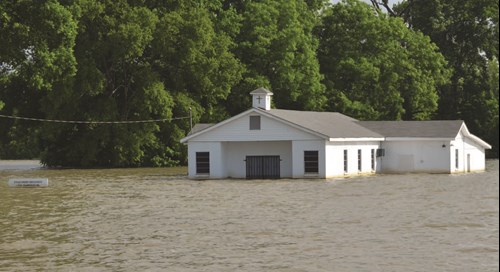
The 2019 flood broke all duration records set in 1927. The Mississippi River first rose above flood stage in the first week of January in Baton Rouge and was above that threshold through June (more than 175 days as of this writing). Similar duration streaks occurred at Red River Landing (near the Mississippi-Louisiana border), Natchez, and Vicksburg.
“Normally, like in 2011,” Smith said, “we started talking about the flood in April, in May the flood happened, and in June, when we talked about it, it was over. This is the first time we’ve had a flood in March and we’re still talking about it in June.”
The historic flooding has ruined billions of dollars’ worth of crops and farmland in the South and Midwest. It also has damaged levees, dams, bridges, roads, and commercial traffic on the Mississippi River. The flood of 2019 clearly has altered the lives of thousands of Mississippians and placed a great deal of stress upon area wildlife. The flooding and stagnant water has harmed more than 550,000 acres in the Mississippi Delta, almost half of which was farmland. Naturally, it has been a trying time for Delta farmers and residents who have been seeking federal assistance.
“Tell me anywhere else in the U.S. where 500,000 acres have been flooded for three months, and we would have some high officials coming here to see what could be done to help,” Delta farmer Clay Adcock told the Delta Business Journal. “We have been ignored because we are a rural area. But we are an important rural area with major productivity and a lot of wildlife. We have small towns with many good people who are really struggling.”
COMMERCE VS. CONSERVATION
As the waters slowly receded over the summer, residents were adding up the losses and looking ahead. After being flooded for almost half a year, many were wondering: Is this the new normal? Voices have gotten louder about how this – and any future – flooding in the Yazoo Backwater Area could be prevented if a pumping station were in place.
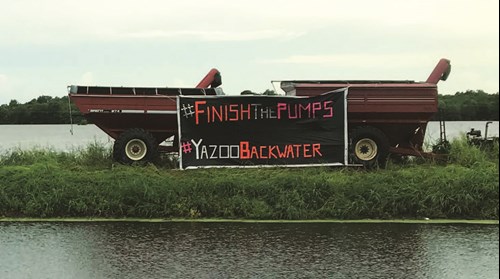
"Giving up my home that I've lived in for 41 years, that I’ve raised my children and grandchildren in — and nobody cares,” Holly Bluff resident Mary Bluff told The Clarion-Ledger. “That’s what’s sad. It's very sad that people have to live like this when it’s not necessary.”
Mississippi is the only state along the Lower Mississippi River that does not have a backwater pump system to relieve high-water effects. USACE’s Smith told the Commission in June that pumps in the Yazoo Backwater Area would have made a positive impact.
“I can’t talk about where all (this) is going or if it’s going anywhere,” said Smith of the pumps in the Yazoo Backwater Area, “but I can talk about the projects that exist and how effective they (the pumps) are. They are very effective. They work flawlessly.
“In the Red River (Louisiana) Backwater Area, that pump had been running off and on for three or four months. It did not rain quite as much as the Yazoo, but they’re harvesting their crop right now.”
The Commission has since voted unanimously to support an initiative to build a pump system in the lower Mississippi River Basin to lessen the impact of high water in Mississippi. Commission Chairman Scott Coopwood, whose region has been hardest hit, says the Commission’s support is important.
“This year’s dramatic flooding event in the lower Mississippi Delta shows the necessity of a pump system, which would significantly reduce flooding in the Mississippi River backwater,” Commissioner Coopwood said. “Preventive measures such as this would benefit area residents, wildlife, and the economy in the region.”

IMPACT TO WILDLIFE
There is not enough clear data to suggest how the lengthy duration of the 2019 flood will impact the population numbers of white-tailed deer, waterfowl, or small game within the next few years. However, one can easily assume that it already has had a major influence on habitat and available food sources.
“People don’t understand how bad this has been,” Eddie Hatcher, District 1 Supervisor for Issaquena County told the Commission as part of its public forum in June. “I live on (Route) 465 in the floodwater, and when I go out every day … there are new dead animals along the highways or laying out in the yard.
“Wildlife is our resource in the Delta. We do not want to lose our resource.”
DEER
MDWFP monitored the 2019 flood and the deer herd, as deer were confined to the levees and other small areas of high ground. MDWFP Deer Program Coordinator William T. McKinley said there will be a lot to learn from the flood, even though the full impact of this natural catastrophe might not be known for years. MDWFP has been conducting live deer counts and mortality counts along stretches of the mainline levee. These surveys revealed many deer in poor condition and mortality among the age classes.
Much of the affected area is within a Chronic Wasting Disease (CWD) Management Zone, and feeding has been banned since the discovery of the disease. The primary reason for the ban is to prevent unnatural concentration of deer, thus potentially minimizing the spread of CWD. Unnatural concentrations were occurring because of the floodwaters and with deer health declining, MDWFP chose to suspend the ban and allow property owners to provide supplemental feed in this area by permit. Feed recommendations were provided by the Deer Lab at Mississippi State University, and the feed was limited to alfalfa hay or a pelletized feed ration containing no more than 16% protein. Grains such as corn and higher protein feeds were not allowed, as digesting these feeds and grains would have negatively affected the deer, likely with fatal results. Additionally, MDWFP established and maintained multiple feed sites in areas with high deer concentrations.

Many questions have been asked of MDWFP biologists, such as “After being pushed out for over seven months, will the deer move back into their former home ranges? What is the impact on the fawn crop? Will the habitat have time to recover before fall once the water recedes? How will antler growth be impacted?”
McKinley said the biologists are asking those same questions and need data to get the answers.
“We are working with Mississippi State University to develop and implement a survey technique once the waters recede,” McKinley said. “This will require the assistance of landowners and wildlife managers throughout the affected area. We plan to contact the landowners and deer managers to put this plan into action this fall. We know that the answers will vary based on how far the deer had to flee the water and the amount of food resources available in the area they chose to stay in the flood.”
McKinley also noted that the effects of this flood would likely be seen in future generations of deer in the area.
“Recent research at MSU has revealed maternal impacts can linger into the future. Fawns from this year will be born and nursed from less healthy mothers,” McKinley said. “The fawns born in 2020 may even show effects if the does do not have sufficient time to restore their bodies this fall. Through harvest data in our Deer Management Assistance Program (DMAP), we will be watching these cohorts over their lifetime and documenting flood effects on the deer herd well into the future.”
Finally, McKinley said that white-tailed deer are a resilient species. For example, an anthrax epidemic killed more than 90% of the deer on some areas of Bolivar and Coahoma counties in the early 1990s. Within just a few years, managers were again harvesting antlerless deer to control the population.
TURKEYS
According to MDWFP Turkey Program Coordinator Adam B. Butler, populations along the Mississippi River have always ebbed and flowed with flood-waters. Floods during the nesting and early brooding season (April until late June) wash away most reproduction in a spring flood year. Luckily, populations along the Mississippi River tend to be more vigorous than elsewhere, and often respond with big hatches in years when floodwaters stay at bay.
Although this boom-bust cycle can be frustrating for hunters, Butler said its up-swings are sufficient to maintain populations over the long term. Without a doubt, 2019 will be a reproductive-bust year for wild turkeys along the Mississippi River and in the south Delta. In contrast, available data from the previous summer brood surveys suggest 2018 produced a strong hatch that should have bolstered regional populations considerably.
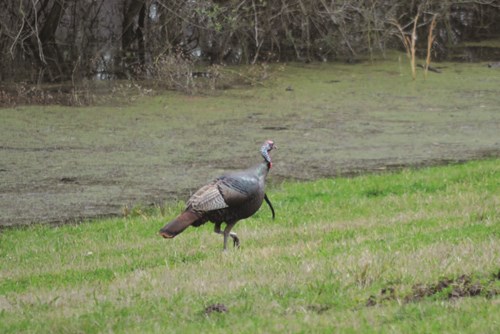
Going forward, the great unknown is how this cohort of birds faired during the 2019 flood. Short duration floods are typically not an issue for adult turkey survival, especially when they coincide with bud-break in the spring. Under those normal flooding circumstances, turkeys that are unable to find high ground simply persist in the tree canopies until the waters recede. The flood of 2019 was far from normal in both its duration and extent. Some direct mortality from the flooding is likely to have occurred; the question will be whether these losses were enough to erase the increase from the 2018 hatch and further reduce numbers which have largely been declining for nearly a decade.
SMALL GAME
The Mississippi Delta is a popular hunting ground for small game hunters. Abundant populations of squirrels and rabbits attract hunters from all over. Unfortunately, small game will also be negatively affected, at least initially, by the unprecedented duration of flooding in the south Delta.
MDWFP Small Game Program Coordinator Rick Hamrick said squirrels have the advantage of riding out some flood events in the trees. However, with lingering high-water levels, squirrels will likely have to move to drier areas to find food resources. Although mostly tree-dwellers, squirrels spend significant amounts of time on the ground searching for a variety of foods. As individuals move out of flooded areas, there will be more stress on animals as they adapt to unfamiliar surroundings and compete for space and food. Summer is typically one of the more productive periods for young squirrels. Locally, reproduction could be negatively affected by the stress and displacement of animals.

Squirrels will recolonize from surrounding areas when the water finally recedes. If acorn and other hardwood seed crops are poor this year, squirrel numbers will be slow to rebound during the coming hunting season. There could be a lag time of a year or two before those populations are back to what hunters were used to, provided yearly water level changes return to more average cycles.
Rabbits will also be displaced by deeper water. They are capable swimmers, said Hamrick, so many rabbits that began to move out as waters rose should have been able to find dry ground. However, they are facing the same stresses for limited resources. Any animal that is forced into unfamiliar surroundings or unfavorable cover is also going to be more vulnerable to predators.
Perhaps the biggest unknown right now is how those forests are going to fare over the next few years in response to longterm flooding. In mature forests, some sporadic tree mortality is not going to be detrimental to squirrels. Flood effects on hardwood seed crop production for the next few years will likely have the greatest influence on squirrels. However, with disaster can come opportunity. Rabbits could respond positively for a few years to new ground cover growth created by sporadic tree mortality and soil disturbance caused by flooding. It is unknown just how long it will take small game populations to rebound after this flood event. However, they are resilient to these types of disasters and will come back when conditions are favorable again.
WATERFOWL
High water levels from spring and summer flooding could benefit resident waterfowl like wood ducks, black-bellied whistling ducks, and Canada geese by providing abundant wetland habitat for feeding and for raising young. Some oxbow lakes, sloughs, and other natural wetlands could also potentially benefit from high water levels flushing through them and stimulating aquatic vegetation, which can benefit waterfowl later in the year. These natural wetlands serve an important role for early migrating waterfowl, particularly blue-winged teal and gadwall, during the early fall.
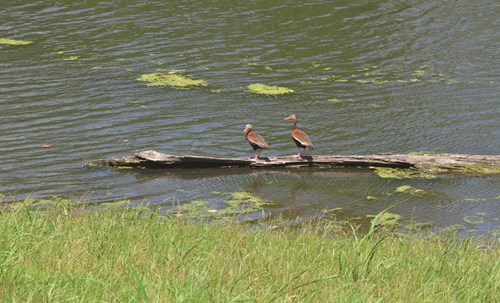
However, the timing and duration of flooding will surely change the habitat and subsequent food types that will be available for migrating waterfowl when they arrive in parts of Mississippi later this fall and winter. A large portion of agricultural crops, which are typically flooded for wintering waterfowl, will not be available like they have been in previous years. With thousands of acres of cropland underwater past the normal planting dates for most crops, there will be a significant reduction for some areas in the amount of corn, rice, soybeans, and other crops ducks normally feed on.
Despite these losses, MDWFP Waterfowl Program Coordinator Houston Havens is optimistic that waterfowl foods will still be available, they just maybe in a different form. “Waterfowl habitat in much of the lower Mississippi Delta will largely depend on when the water comes off,” Havens said. “If areas become dry enough for equipment access in mid to late summer, there could still be an opportunity for landowners and managers to do some late plantings and other active management for waterfowl foods. Otherwise, flood-impacted areas will depend on natural moist-soil plants to provide a larger portion of the food source this winter.”
BEARS
Mississippi has a small but growing bear population. Bears may be one of the least affected species when it comes to enduring a major flood event. The great thing about bears is they are highly adaptable and are good climbers and swimmers. Effects from extensive flooding on bears in past years, such as 2011, have been handled quite well. However, this year is unique in that the bears dealt with extensive flooding for a prolonged period.
There were two females radio-collared in Bolivar County and a telemetry flight was conducted on June 19 in an attempt to find them (see related story, p.40). Both bears were located and near to previous locations gathered in June and October 2018 and early February 2019, all well within their normal home range. One bear had a good bit of dry ground in the immediate vicinity, while the others were surrounded by more extensive flooding with only a few ridges emerging from the water. Based on a visual encounter with one of the females in June 2018, she should have bred last summer and had cubs this past winter. The plan is to be on the ground to catch both bears as soon as the water recedes to assess their overall health and that of the cubs if present. At that time, the old VHF collars will be replaced with GPS satellite collars that will allow MDWFP to monitor the bears in near realtime. Motion-sensitive cameras also will be deployed to monitor movement, behavior, and hopefully, the presence of cubs of the year.
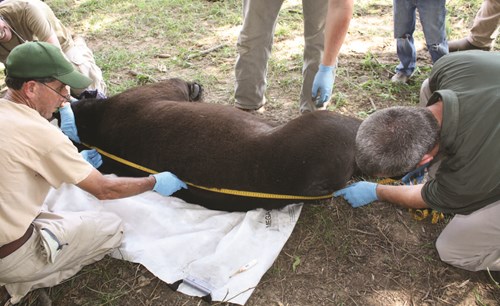
In late June, the Wildlife Bureau staff conducted black bear trapping in areas of the south Delta affected by flooding. Efforts were focused on the limited areas of dry ground in the region where bears had been observed regularly. MDWFP successfully trapped three bears, two males, and one female. The female and one of the males were fitted with GPS satellite collars, which will allow MDWFP to monitor their movements over the next 2-3 years via satellite signal. All captured bears are given a complete “workup,” which consists of recording weight and a variety of morphometric measurements and assessing their general health and body condition. Also, a small premolar tooth is removed to determine age, a hair sample is collected for DNA analysis to determine relatedness and geographic origin, and ectoparasites are collected as part of a tick surveillance study in the eastern U.S. Numbered tags are attached to each ear and each bear receives a microchip under the skin for future identification (also known as a PIT Tag). During the anesthesia, the bears’ vital signs (temperature, heart rate, and respiration) are monitored and recorded to determine if any remedial measures are necessary. Normally, a “workup” takes less than an hour and the bear is then monitored at a distance as it recovers from anesthesia and gets back on its feet.
Monitoring these radio-collared bears as the floodwaters begin to recede will be vital to our understanding of the ecology of the bears of the south Delta. Will they stay where they are currently? Will they return to a former home range that is currently inundated? Will the female den and give birth to cubs next winter? MDWFP hopes to answer these questions and many more in the months and years ahead.
FISH
In general, higher water levels are good for fish, especially when that water increases access to a river’s floodplain. When the Mississippi River floods, most game fish species like bass, crappie, and bream move onto the floodplain and begin feasting on insects, worms, and other terrestrial prey items. Not only does the floodplain provide fish with a buffet of new food choices, but it also provides them with plenty of high-quality spawning habitat.
MDWFP biologists have conducted research on the crappie population in Lake Beulah, a river-connected oxbow in Bolivar County, and found a direct correlation between river level and the strength of the crappie spawn. The strongest crappie spawns were found to have occurred in years when the spring water levels were the highest, and the weakest crappie spawns occurred when the spring water levels were lowest. So generally speaking, flooding allows game fish access to good habitat where they can feed heavily and successfully spawn.
Flooding also can have negative impacts on the state’s water bodies, game fish species, and the anglers who try to catch them. Sometimes chemicals, pesticides, or other harmful liquids are washed into the water during floods, and these pollutants can kill fish and other aquatic animals. Large amounts of organic matter that are washed into lakes and rivers may lead to low dissolved oxygen levels as this material decomposes. This, in turn, can lead to fish kills in these waters. Fish kills on public water should be reported to the Mississippi Department of Environmental Quality (MDEQ) at (601) 961-5701 or the Mississippi Emergency Management Association at (800) 222-6362.
Flooding also allows invasive species of plants and animals to gain access to new areas. For example, water overtopping the Muddy Bayou structure allowed silver carp to easily swim into Eagle Lake, and high water has helped northern snakeheads move from Arkansas to Mississippi waters. Flooding also makes it difficult for anglers to fish because the river is dangerous, boat ramps are underwater and the fish are spread out on the floodplain.
MARINE LIFE
This year’s flood marked the first time Bonnet Carré Spillway gates had to be opened twice in one year to relieve pressure on the levee system that protects New Orleans from flooding. The spillway, located about 10 miles west of New Orleans, allows floodwaters from the Mississippi River to flow into Lake Pontchartrain and on into the Gulf of Mexico. The influx of fresh water into the Mississippi Sound has led to the deaths of more than 130 dolphins and 150 sea turtles.
The reduction of salinity also was cited as the cause of an algae bloom that led MDEQ to close most of the beaches along the Gulf Coast in late June and early July. Warnings were issued to the public to not eat fish or any other seafood taken from any affected waters.
While salinity levels started to increase mid-June, University of Southern Mississippi's School of Ocean Science and Engineering researchers found that salinity levels in the Mississippi Sound continued to decrease again as winds pushed surface waters to the north entrapping flow from the spillway, according to a June 25 media release by Mississippi Department of Marine Resources (MDMR).
Also according to the release, the Institute for Marine Mammal Studies and Mississippi State University reported in June that frequency of dolphin and turtle strandings has decreased considerably. For the week of June 16, no dead dolphins and only one dead sea turtle had been encountered or reported.
MDWFP staff members David Bean, Russ Walsh, Adam B. Butler, Rick Hamrick, William T. McKinley, Houston Havens, Larry Bull, and Nathan Aycock contributed to this report.
